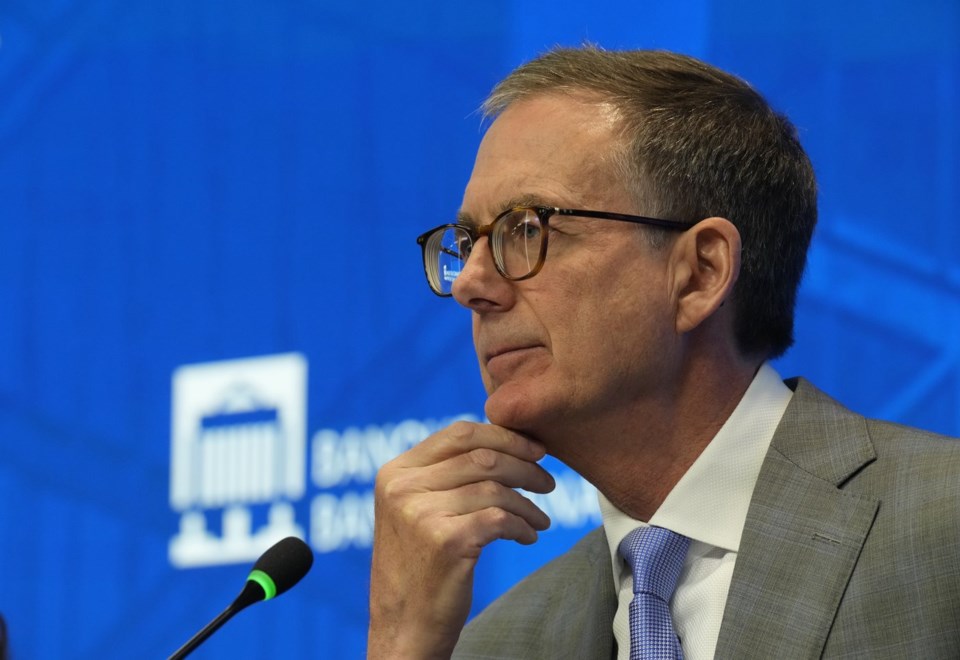OTTAWA — Signs of resilience in the Canadian economy were enough for the Bank of Canada to leave its benchmark interest rate unchanged Wednesday, but the spectre of U.S. trade uncertainty continues to cast a shadow over the central bank’s decisions.
The central bank’s policy rate remains at 2.75 per cent after a third consecutive hold.
With a backdrop of considerable trade uncertainty, Canada’s economy has yet to deteriorate sharply in the face of U.S. tariffs and underlying inflation is showing some stubbornness.
Bank of Canada governor Tiff Macklem said the economy is showing “some resilience” so far.
But he said that if the economy weakens more and price pressures from tariffs are contained, "there may be a need for a reduction in the policy interest rate."
The Bank of Canada lowers its policy rate when it wants to stimulate the economy but keeps borrowing costs elevated when it’s worried inflation will rise.
CIBC senior economist Andrew Grantham said in a note to clients Wednesday morning that the Bank of Canada "appears to be getting a little more comfortable" with the idea that future rate cuts could be needed to support the economy.
He said Macklem's language gave a hint that rate cuts could be on the table for September, but cautioned that upcoming economic data will have more sway.
TD Bank senior economist Andrew Hencic said in a note that scenarios released alongside the central bank's rate decision Wednesday show Canada's economic growth could rebound from the tariff hit but remain below trend for the foreseeable future.
That "leaves the door open" to additional interest rate cuts, Hencic said, as long as inflation is stable.
Macklem said U.S. tariffs have put domestic growth on a "permanently lower path."
"The sad reality is that tariffs mean the economy's going to work less efficiently. It means there's going to be less income. So there's going to be less consumption," he said.
Macklem said the rate decision, which was widely expected by economists, came from a "clear consensus" among monetary policymakers.
Ontario Premier Doug Ford said in a post on X that he was "shocked" by the Bank of Canada's decision to keep interest rates unchanged as the trade war threatens Canadian jobs.
"Rather than wait around and let President Trump's tariffs do even more damage to our economy, the Bank of Canada needs to cut interest rates now," he said.
Asked to respond to Ford's comment during the press conference, Macklem emphasized that the central bank's decisions are independent of the political process. He added that the Bank of Canada's mandate remains keeping inflation low and predictable for Canadians.
"We will support the economy through this period of upheaval, but at the same time, we are going to make sure that a tariff problem does not become an inflation problem," he said.
Macklem noted later that sector-specific weakness is best addressed by fiscal policy — targeted government support, in other words.
Going forward, the Bank of Canada will be watching how much tariffs affect business activity and demand for Canadian exports, and whether higher costs from those import duties are passed on to customers.
U.S. effective tariff rates are “less than were threatened,” Macklem noted, but are still higher than recent historical experience. The odds of a “severe and escalating” global trade war have diminished in recent months, he said.
The Bank of Canada published a monetary policy report alongside its rate decision Wednesday, but that report once again did not include a single, central forecast for the economy.
Instead, the bank offered a scenario based on the current tariff level persisting, and two others that outline both a de-escalation and a further ramp up of tariffs. Each of those case studies sees at least some level of tariffs persisting.
Macklem said that, between various exemptions, the central bank sees the effective U.S. tariff rate on Canada at roughly five per cent today, up from virtually zero at the start of the year.
The bank’s monetary policymakers also assume a vast majority of Canadian goods will be exempt from tariffs over the coming years thanks to their compliance with the Canada-U.S.-Mexico Agreement as companies rush to get certified.
In the status quo scenario, the Bank of Canada sees the economy rebounding through the rest of this year after an estimated decline of 1.5 per cent in annualized real gross domestic product last quarter.
Inflation would also hold around two per cent through the end of 2027 in this outcome as the forces pushing prices higher are roughly offset by the forces dampening them.
A de-escalation scenario would cut U.S. tariffs on Canada in half, while the escalation alternative would see the United States put a 10 per cent blanket tariff on all Canadian goods without any CUSMA exemptions.
The more optimistic scenario sees growth rebound faster, but the escalated scenario would see inflation rise and the economy fall into a recession for the rest of 2025.
Trump has threatened to impose a 35 per cent duty on Canadian imports starting Friday if a trade deal isn’t struck between the countries before then. The Bank of Canada’s forecasts don’t specifically address the impact of that possible outcome.
This report by The Canadian Press was first published July 30, 2025.
Craig Lord, The Canadian Press




